
http://www.iaeme.com/IJMET/index.asp 1792 editor@iaeme.com
International Journal of Mechanical Engineering and Technology (IJMET)
Volume 10, Issue 03, March 2019, pp. 1792–1805, Article ID: IJMET_10_03_181
Available online at http://www.iaeme.com/ijmet/issues.asp?JType=IJMET&VType=10&IType=3
ISSN Print: 0976-6340 and ISSN Online: 0976-6359
© IAEME Publication Scopus Indexed
SMART GRID ISLANDING, FAULT DETECTION
AND CLASSIFICATION WITH DISTRIBUTED
GENERATION BASED ON WAVELET
ALIENATION CURRENT SIGNALS APPROACH
Kamala Devi Kolavennu
Department of Electrical and Electronics Engineering
Bapatla Engineering College, Bapatla, Andhra Pradesh, India
Abdul Gafoor Shaik
Department of Electrical Engineering
IIT- Jodhpur, Rajasthan, India
ABSTRACT
The Distributed generation (DG) is gaining significant attention due to increase in the
demand for electricity. Distributed generations are mostly used with the association of power
distribution systems to energize local loads and network. Islanding is technically an undesirable
condition that demands necessary steps to reduce negative effects in maintaining stability of the
system. In the present work, alienation technique has been applied to detect and differentiate
islanding, faults and sudden load change and faults have been classified. A radial system with
four Distributed Generations (DFIG wind generator) connected to the source through common
coupling point (PCC) has been used for comprehensive study of this technique. Current signals
were decomposed with Daubechies (db1) wavelet in order to get approximate coefficients at
each bus. Coefficients of Alienation are computed by using the wavelet based approximations
over a length of half cycle moving window . The alienation coefficients were used to compute
Islanding index and fault index. The same indices were compared with threshold to differentiate
Islanding, faults and sudden load change. The proposed algorithm has been tested for various
incidence angles for both islanding condition and faults. This technique is established to be
robust in detecting islanding condition, faults and impact of sudden load change.
Key words: Distributed generation, Alienation coefficients, Distribution network,
load change, Islanding index, Wavelet transform
Cite this Article: Kamala Devi Kolavennu and Abdul Gafoor Shaik, Smart Grid
Islanding, Fault Detection and Classification with Distributed Generation Based on
Wavelet Alienation Current Signals Approach, International Journal of Mechanical
Engineering and Technology 10(3), 2019, pp. 1792–1805.
http://www.iaeme.com/IJMET/issues.asp?JType=IJMET&VType=10&IType=3

Kamala Devi Kolavennu and Abdul Gafoor Shaik
http://www.iaeme.com/IJMET/index.asp 1793 editor@iaeme.com
1. INTRODUCTION
Penetration of the distributed generation in power distribution networks increases rapidly in the
present days. Distributed generation (DG) is also known as non-centralized power generation
or dispersed generation which refers to the production of Electricity near the consumption place.
The resources used in distributed generation are renewable energy sources and cogeneration
i.e., production of heat and electricity simultaneously. DGs are having some advantageous
characteristics like free location in the network area, relatively small generated power, increased
reliability of the Grid, reduced transmission and distribution line losses, better voltage support
and power quality improvement[1].
The standby generation, peak shaving, utility grid enhancement, load management are
various applications of the distributed generation. However many technical issues and
difficulties arise in the association of DG units with the Grid. Islanding condition is one of the
most undesirable conditions intentionally or accidentally takes place in DGs. According to
IEEE STD 1547-2003, in islanding condition, there is accidental or intentional disconnection
of the grid from distribution network system and the distributed generation continuously feed
the network and local loads[2]. Due to this Islanding condition, various operational problems
arise related to power quality, safety hazard, voltage and frequency instability and damage to
system equipment [3, 4]. The unsynchronized reclosing of the grid to distribution system
may trigger damage to the power electronic conditioning equipment of the distributed
generation. The standard of IEEE 929-2000 specifies particularly the disconnection of
distributed generation once it is islanded [5] and this issue is addressed by IEEE STD 1547-
2003 [6].Islanding detection techniques are broadly classified into remote (central) and local
techniques. A detailed review on islanding has been given by Khamis, Aziah [7]. Remote
methods are associated with islanding detection methods on the utility side where as local
methods are associated with detection of islanding on DG side. Remote methods are used to
detect unintentional islanding by monitoring voltage and frequency parameters [8]. Remote or
central methods are independent of number of inverters, generator type, and system size and
penetration level. Local techniques for islanding detection are based on the measurement of the
system parameters on DG side such as voltage, frequency, current and harmonic distortion [9].
Comparative analysis of anti islanding technique depends on application and cost and ability of
occurrence of islanding on feeder has been presented by P. Deshbhratar, R. Somalwar and S.
G. Kadwane [10]. Local Islanding detection techniques are further classified into passive and
active technique methods, and hybrid technique methods [11, 12]. Anti-islanding technique
method has been introduced by J. Yim, C.P.Diduch, L. Chang on the basis of proportional
power spectral density as a formalised measure [13]. A new approach to islanding detection by
extracting the negative sequence component of the current and voltage has been presented by
S. R Samantha Ray and Trupti Mayee Pujhari[14]. K. Narayana presented a scheme on a
priority based load shedding to detect islanding in case of multiple DG units [15].Ahmad G.
AbdElkadar reported a new islanding technique for DFIG wind turbine by using artificial neural
network [16]. R. K. Ray, N. Kishore [17] proposed a wavelet and S-transform based scheme by
considering a negative sequence component of the voltage signal extracted at point of common
coupling.J. A. Laghari [18] developed an islanding detection technique by using average rate
of change of reactive power and load shift strategy.
The effectiveness of different fault detection methods were studied by S. S. Gururajapathy
H. Mokhilis like fuzzy logic, artificial intelligence, , Genetic algorithm etc, [19]. Transmission
line protection scheme based on Wavelets are proposed by Abdul Gafoor and Ramanarao [20].
Rathore and Shaik has proposed the protection schemes for transmission line from faults with
the use of wavelet based alienation technique [21, 22].A protection scheme has been introduced
by Masoud and Mahfouz for transmission lines based on alienation coefficients [23].

Smart Grid Islanding, Fault Detection and Classification with Distributed Generation Based on
Wavelet Alienation Current Signals Approach
http://www.iaeme.com/IJMET/index.asp 1794 editor@iaeme.com
In deed there is a need to investigate a protective scheme which requires fast detection with
less computational complex. In this present work the proposed algorithm can detect islanding
and faults within quarter cycle.
2. THE ALIENATION ALGORITHM BASED ON WAVELETS
2.1. The Wavelet Transform
There is effective use of Wavelet transform to analyse transients of current and voltage signals
in frequency as well as time-band. To decompose the signal in high and low frequency bands a
set of basic functions called Wavelets, are used, which are acquired from a mother wavelet by
dilation and translation. Therefore, the incidence of each frequency and amplitude can be found
precisely. The Wavelet Transform is explained as a series of a function {h (n)} (high pass filter)
and {g (n)} (low pass filter). The scaling and wavelet functions can be described in equations
as follows.
∅(𝑡)=√2∑ℎ(𝑛)𝜑(2𝑡−𝑛)(1)
Ψ(𝑡)= √2∑𝑔(𝑛)𝜓(2𝑡−𝑛) (2)
Where, g (n) = (-1) n h (1-n)
The factor √2 maintains the norm of the function for the time compression factor 2. The
time compression factor is generally correlates to the scale. The selection of mother wavelet is
based on the type of application. This paper used Daubachies wavelet which is suited for this
application to get best results.
2.2. Alienation Coefficients
In the suggested algorithm the current signals have been sampled over a half cycle.
Approximation coefficients are acquired by applying wavelets to these current signals The
alienation coefficient based on approximation decomposition (Coefficients) is calculated as:
𝐴𝐴=1−𝑝𝑎
2 (3)
Where, pa is the coefficient of correlation calculated based on approximations. The
correlation coefficient based on approximation coefficient is calculated as
𝑝𝑎=𝑁𝑠(∑𝑟𝑎𝑠𝑎)−(∑𝑟𝑎∑𝑠𝑎)
√[𝑁𝑠∑𝑟𝑎
2−(∑𝑟𝑎)2][𝑁𝑠∑𝑠𝑎2−(∑𝑠𝑎)2 (4)
Where, Ns is the number of samples per half cycle, absolute value of samples at t0 is denoted
by ra .Absolute value of samples consider in previous moving window of half cycle is denoted
by sa. The variance between two signals is defined as the alienation coefficient. Its value is
between 0 and 1.
2.3. Weighted alienation coefficients
It is needed to apply the concept of weighted alienation coefficients to detect the transients of
faults at PCC when faults are computed at DGs and for load changes. Simple arithmetic gives
equal importance to all values in a series. In some cases, all the values in a series do not give
same weight age. In such cases weighted average is more suitable for calculations. The concept
of average of weighted Alienation coefficients is as follows. It is used to increase the relative
importance of any quantity (of our interest) with respect to other quantities. For which each
value is multiplied by a weight according to its importance. The weighted average for any input
x can be computed by using the following equation (5) and procedure.

Kamala Devi Kolavennu and Abdul Gafoor Shaik
http://www.iaeme.com/IJMET/index.asp 1795 editor@iaeme.com
5
1
i
i
x avg WiXi
(5)
i= Total number of inputs.
Xi is alienation coefficient at each bus of four DGs and PCC where, i = 1, 2,3,4,5.
Get Max (x1, x2, x3, x4, x5) = n.
Divide each alienation value of DGs and PCC by n to get weights. The weights will be
xi/n=wi where i=1 to 5.
Multiply every alienation coefficient of four DGs and PCC with their respective weights
(wi).Then get average of these values for all three phases.
Figure 1. Line diagram of the system
The single line diagram of proposed system is shown in Fig. 1. The base power is about 10
MVA. This system contain radial distribution system with 4 wind farms (DG units), which
connected through Point of Common Coupling (PCC) to the main supply system and it operates
at a power frequency of about 50 Hz. These DG units are connected at about a distance of 30
km with the distribution lines of pi-sections. The data of the DGs, generator, distribution lines
and loads and transformers are considered from Ref. [17].
The three phase currents at a point of common coupling of distribution line and DGs are
sampled at 6400 Hz. These samples are acquired over a moving window of half cycle length.
These current samples have been decomposed with a db1 wavelet to get approximation
coefficients of third level (A3). CA, the Alienation coefficient is evaluated by comparing the
approximate coefficients of the current window, with those of the previous window of same
polarity.
These two consecutive windows, under normal conditions, have similar set of
approximations, hence the Aa remains zero. But in the case of islanding, fault or any other
abnormal condition, the approximate coefficient of the current window should differ from those

Smart Grid Islanding, Fault Detection and Classification with Distributed Generation Based on
Wavelet Alienation Current Signals Approach
http://www.iaeme.com/IJMET/index.asp 1796 editor@iaeme.com
of previous window of same polarity. Hence, the alienation coefficient would increase from
zero to a certain value indicating disturbances.
3. PROPOSED ALGORITHM
Table 1 Parameters adopted in the present work
S.NO
COMPONENT
SPECIFICATION
1.
Generator
Rated short circuit MVA=1000
Rated KV=120,Vbase=120kv,f=50Hz
2.
Distributed generations(DGs)
(DG-1 to DG-4)
Six Doubly fed induction generators
(9MW) of each wind turbine of rating1.5MW
are joined to a 25kv grid through
a length of 30km, 25 kv feeder.
3.
Distribution lines 1 to 4
PI-Section,30km each, rated MVA=
20, Rated KV=25kv,Vbase=25kv, R0=
0.11530Ω/km,R1=0.4130Ω/km,L0=
1.05e-3H/km, L1=3.32e-3H/km,
C0=11.33e-009F/km,X1=5.01e-009
F/km.
4.
Transformer T1
Rated MVA=25,Vbase=25kv,Rated
KV=120/25, X1=0.10p.u, R1=0.003750
p.u,Rm=500.00p.u, Xm=500.00 p.u.
5.
TransformerT2 to
Transformer T5.
Rated MVA=10.00,rated kv=575v/25kv,
Vbase=25KV, X1=0.10, R1=0.003750
p.u, Rm=500.00 p.u, Xm=500.00 p.u,f=50hz
6.
Load L-1
15MW,5MVAR.
7.
Load L-2 to Load L-5
8.0MW,3MVAR.


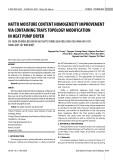
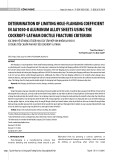

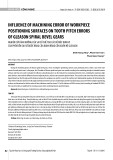

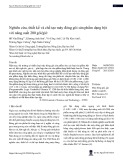
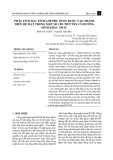
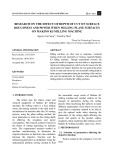


![Bài tập tối ưu trong gia công cắt gọt [kèm lời giải chi tiết]](https://cdn.tailieu.vn/images/document/thumbnail/2025/20251129/dinhd8055/135x160/26351764558606.jpg)













